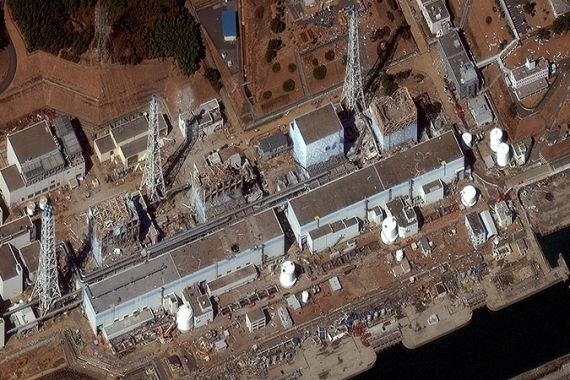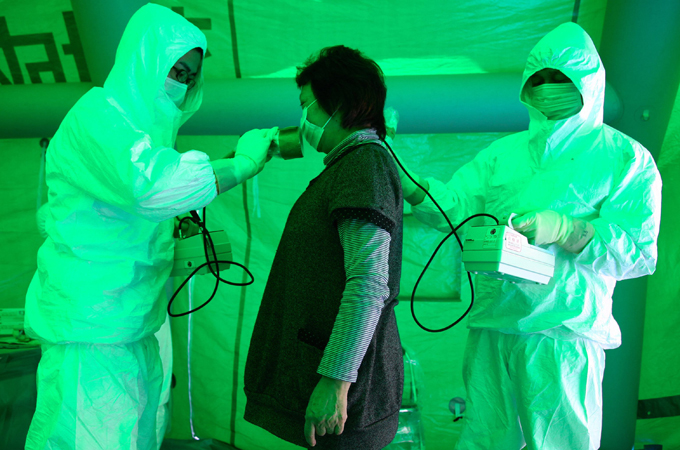Japan nuclear plant ‘improving’
Government says cooling efforts at quake-hit Fukushima complex showing improvement, but situation remains uncertain.

 |
| Pressure inside reactor Unit 3 at the Fukushima nuclear plant has stabilised, TEPCO, the plant”s operator said [AFP] |
Reactors at Japan’s tsunami-damaged nuclear power plant were showing some improvement but the situation remains uncertain, Japan’s deputy chief cabinet secretary has told reporters.
The operator of the Fukushima Daiichi nuclear power plant said on Sunday it may take several days for power to be restored at the Unit 3 and Unit 4, the most troublesome of the plant’s six reactors.
Keep reading
list of 4 itemsAfter the Hurricane
World’s coral reefs face global bleaching crisis
Why is Germany maintaining economic ties with China?
Tokyo Electric Power Co (TEPCO) engineers have already reconnected power to the cooling systems of Unit 1 and Unit 2.
Hidehiko Nishiyama, a safety agency official, had said earlier that rising pressure inside the containment vessel of Unit 3 made the release of radioactive gas necessary to prevent a more dangerous build-up.
However, TEPCO later backed away from that plan, saying that pressure inside the reactor had stabilised.
Radiation levels
Graham Andrew, a senior official of the International Atomic Energy Agency (IAEA), said radiation levels in major Japanese cities have not changed and remained below dangerous levels.
He said the IAEA could confirm that in some areas near the plant radioactive iodine had been detected in some freshly grown vegetables.
Earlier on Sunday the government warned that tests of spinach and milk from areas as far as 120km away exceeded safety limits.
Tap water farther away turned up tiny amounts of radioactive iodine in Tokyo and other areas.
Japan’s health ministry also said in a statement that radiation levels exceeded safety standards in Fukushima and nearby Ibaraki prefecture. It said it had prohibited the sale of raw milk from Fukushima prefecture.
Amid concerns of wider contamination, a nuclear safety official said the government was caught off-guard by the accident’s severity.
The official, Kazuma Yokota, said an explosion at the plant’s Unit 3 reactor last Sunday should have triggered the distribution potassium iodide pills that help reduce the chances of thyroid cancer, but the order only came three days later.
“We should have made this decision and announced it sooner,” Yokota said at the emergency command centre in the city of Fukushima.
“It is true that we had not foreseen a disaster of these proportions. We had not practised or trained for something this bad. We must admit that we were not fully prepared.”
Extent of damage
The full extent of the damage from the quake and tsunami that swept through northeast Japan on March 11 is only starting to emerge, more than a week later.
Homes still lay in ruins, businesses are closed, and power lines remain disrupted.
More than 8,000 were killed by the earthquake and 10-metre tsunami which smashed the country’s northeast coast, wiping whole towns off the map.
Economists estimate that rebuilding from the disaster will cost as much as $200bn for an economy already burdened with public debt twice its $5tn economy.
Some survivors could not even begin the process of cleaning up, as they were still in search of missing love ones.
There are 12,272 still missing from the quake and tsunami, the national police agency said.
“I started cleaning up yesterday but I just couldn’t do it. My brother went missing and I want to look for him first. So I just stopped what I was doing and waited on my brother instead,” said house owner Satoshi Ogasawara.
He has still not found his brother.
‘Lucky escape’
In what some described as a “miracle,” police said an 80-year-old woman and a teenage boy were rescued from the wreckage of a house in northeastern Japan, nine days after the earthquake and tsunami.
|
|
Rescuers found the 16-year-old boy on the roof of his house in the hard-hit city of Ishinomaki, calling out for help, according to the Miyagi Prefecture Police.
Troops of the Self Defence Forces (SDF) have been deployed to the quake-struck region, playing an integral role in recovery efforts.
Offers of aid and support have poured in from scores of countries, including search and rescue teams, and clothes and blankets to ward off near-freezing temperatures in the quake zone.
According to the Japanese foreign ministry, 128 countries and 33 international organisations have offered assistance as of Saturday. Over $10m in financial help has been promised.
In quake-struck cities in the northeast, electricity and water are still in short supply. In some towns, there is not enough water to clean homes caked in mud.
The March 11 tsunami flattened scores of villages, hamlets and towns lining Japan’s northeast coast.